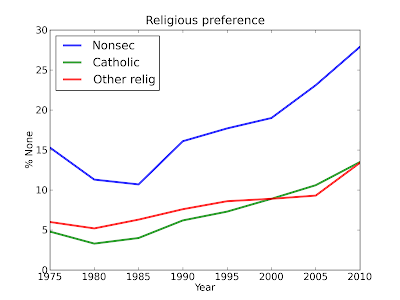Secularization in America, part one.

In the last year or so I have written several articles about trends in religion among college students: Are religious colleges getting more religious? Freshman hordes more godless than ever! Freshman hordes even more godless! All of these are based on data from the Cooperative Institutional Research Program (CIRP) which runs the Freshman Survey, an annual survey of more than 200,000 incoming students at 270 colleges and universities in the U.S. More recently, I read Secularization: In Defence of an Unfashionable Theory, by Steve Bruce. Bruce presents the "unfashionable theory" that as societies modernize, they secularize. In his formulation, modernization includes trends toward individualism, industrial capitalism, science and technology; and secularization means "decline in the social significance of religion." The poster child for secularization is Western Europe, where the social influence of religion has been in decline for centuri...




